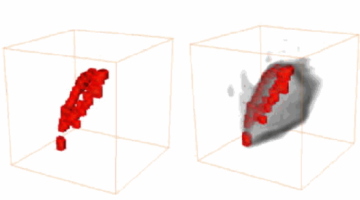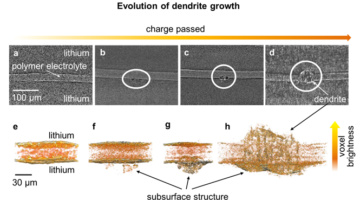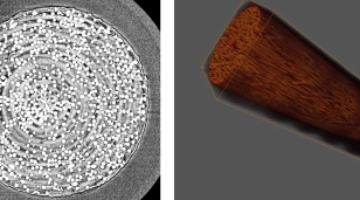Developing ceramic matrix composites (CMCs) to replace the metal alloys traditionally used in jet engines has been a goal for the aviation industry for decades. For more than a year, GE Aviation has used the tomography capabilities at ALS Beamline 8.3.2 to gain insight into their CMC materials, guiding their engineering and design efforts. Read more »![]()
When Rocket Science Meets X-Ray Science
Scientists at the Department of Energy’s Lawrence Berkeley National Laboratory (Berkeley Lab) and NASA are using x-rays to explore, via 3D visualizations, how the microscopic structures of spacecraft heat shield and parachute materials survive extreme temperatures and pressures, including simulated atmospheric entry conditions on Mars. Read more »
3D Visualization of the Behavior of Grease Additives
Lubricants help keep civilization running smoothly, but is there room for improvement? With the goal of increasing the life span and lowering the costs of all kinds of mechanical and biological systems, researchers used x-ray microtomography to visualize the behavior of grease additives under working conditions. Read more »
Getting to the Root of Grapevine Hydraulics
In grapevines, “root pressure” was assumed to play a role in recovering from embolisms (blockages) in a plant’s water-transport systems during drought conditions. To clarify this, researchers used ALS Beamline 8.3.2 to obtain 3D microtomographic images of grapevine stem segments detached from roots and leaves. Read more »
Power-Amplified Predatory Strikes in Trap-Jaw Spiders
Using a combination of high-speed video, molecular phylogenetic analysis, and x-ray microtomography of a family of tiny trap-jaw spiders, researchers discovered that power-amplified predatory strikes evolved four times independently, once the basic trap-jaw body plan was in place. Read more »
Youngest ALS Users Go to the White House
Two seventh graders from Black Pine Circle (BPC) School in Berkeley, who came to the ALS last November on a field trip that included actual beam time earned through peer-reviewed proposals, have now made it all the way to the White House. Read more »
ALS Technique Gives Novel View of Lithium Battery Dendrite Growth
Lithium-ion batteries, popular in today’s electronic devices, could gain significant energy density if their graphite anodes were replaced with lithium metal anodes. But there’s a major concern with substituting lithium—when the battery cycles, microscopic fibers of the lithium anodes (“dendrites”) form on the surface of the lithium electrode and spread across the electrolyte until they reach the other electrode, possibly leading to short circuiting. Researchers have recently discovered that the x-ray microtomography capabilities at ALS Beamline 8.3.2 can give them a novel view of dendrite growth that’s likely to provide the insight needed to stop it. Read more »![]()
Students Get a Taste of ALS User Experience
A group of seventh graders from Black Pine Circle (BPC) school in Berkeley recently had a rare opportunity to experience the ALS as “users” via a scientific research proposal project and field trip. The students were led by science and technology teacher Christine Mytko, who spent the past summer at the ALS through the Industry Initiatives for Science and Math Education (IISME) program. Read more »
Moving Industry Forward: Finding the Environmental Opportunity in Biochar
Using ALS tomography capabilities, the EPA is currently investigating how biochar, a promising biofuel byproduct, sorbs environmental toxins and which kinds of biochar are the most effective. The possibilities for widespread use have already launched entrepreneurial commercial ventures.
Read more »![]()
TE Connectivity Finds Answers in Tomography
TE Connectivity designs and manufactures more than 500,000 different electronic connectivity products for the automotive, energy, industrial, broadband communications, consumer device, healthcare, aerospace, and defense industries. TE has been investigating how ALS tomography capabilities can help the company develop more efficient connectors.
Read more »![]()
![]()
- « Previous Page
- 1
- …
- 3
- 4
- 5
- 6
- Next Page »









